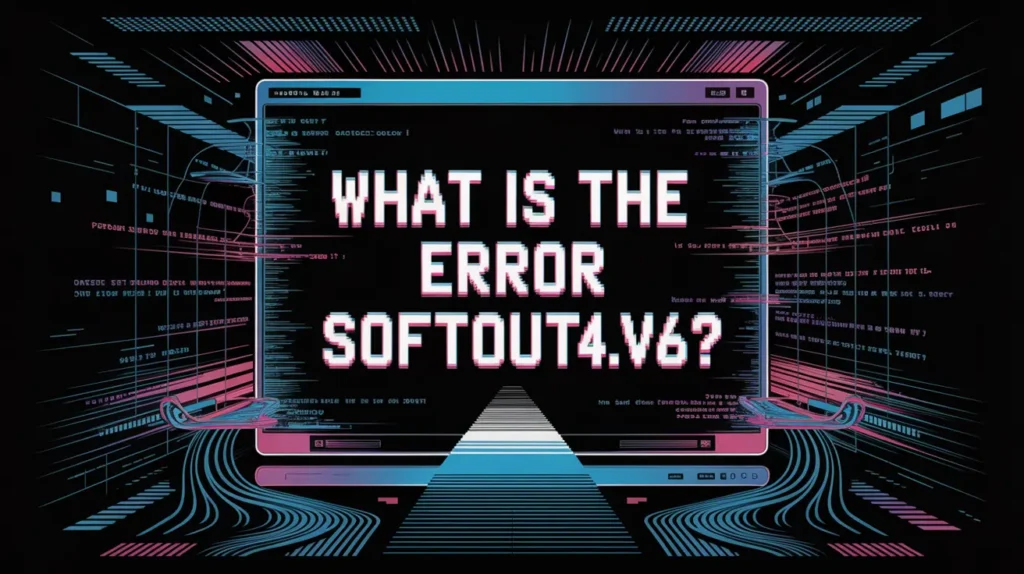In today’s increasingly digital world, software errors can create confusion and disrupt workflow. One such uncommon but disruptive issue is the error SoftOut4.v6. Although not widely documented, users who encounter this issue often struggle to resolve it due to a lack of clear and actionable information. This article provides a comprehensive guide to understanding and fixing SoftOut4.v6.
Profile Biography Table
| Field | Details |
| Error Name | SoftOut4.v6 |
| Error Type | System/Software Runtime Error |
| Common Platforms | Windows OS (various versions), third-party apps |
| First Reported | 2021 (by community users) |
| Impact Level | Moderate to High (depends on software) |
| Associated Applications | Enterprise software, data extraction tools |
| Typical Symptoms | App crashes, system lag, unexplained shutdowns |
| Fix Status | Fixable through system cleanup and patches |
What is the Error SoftOut4.v6?
The error SoftOut4.v6 is a system-level or software-specific error that typically arises during the operation of specialized enterprise applications or legacy systems. Users often encounter it when initiating data transfer processes or performing software updates. It may also appear in error logs, making it hard to detect through basic interface warnings.
Causes of the SoftOut4.v6 Error
Understanding what causes this error is key to resolving it effectively. Common reasons include:
- Corrupted installation files
- Missing or damaged DLL dependencies
- Conflicts with recent software updates
- Outdated system drivers
- Registry entry mismatches
In many cases, the error manifests after a failed software update or during the launch of applications that rely on older system frameworks.
How to Identify the SoftOut4.v6 Error
If you’re unsure whether you’re facing this specific error, here are some signs to look out for:
- A popup with the exact text: “Runtime Error – SoftOut4.v6”
- Application freezing right after launch
- Event Viewer logs showing “softout4.v6.dll not found”
- Windows crashing with code referencing “v6”
Step-by-Step Fix for the SoftOut4.v6 Error
Solving this error typically involves several approaches. Try the following steps in order:
Step 1: Reboot and Check for Updates
Restart your system and install all pending Windows updates. Often, minor issues are resolved this way.
Step 2: Run System File Checker
Use the SFC tool to scan and repair system files. Open CMD as Admin and run:
bash
CopyEdit
sfc /scannow
Step 3: Reinstall or Update Affected Software
If you know which software is triggering the error, uninstall and reinstall it with the latest available version.
Step 4: Clean Your Registry
Use trusted tools like CCleaner to remove broken registry entries that may be referencing SoftOut4.v6.
Step 5: Check Event Viewer Logs
Navigate to Windows Event Viewer to find specific logs. Filter by “Error” level to locate relevant details for further debugging.
Preventing the Error SoftOut4.v6 in the Future
It’s always better to prevent issues than fix them repeatedly. Here are simple steps to help you avoid seeing this error again:
- Keep your OS and software updated
- Avoid using pirated software versions
- Maintain regular system backups
- Use antivirus tools to prevent malware corruption
- Clean your registry monthly with trusted tools
When to Seek Professional Help
If the error persists after all basic troubleshooting, it may signal a deeper system or hardware-level issue. Consider contacting:
- Your system administrator (for enterprise users)
- The application’s support team
- A certified technician if the software is no longer supported
Conclusion
The SoftOut4.v6 error may seem mysterious, but it’s usually manageable with the right approach. Whether it originates from corrupt files, software conflicts, or registry mismatches, resolving it requires patience and systematic action. By using the solutions provided here, you can not only fix the issue but also prevent it in the future.
Read more: Tech Trends pboxcomputers – Exploring the Future of Innovation and Computing
FAQs About the Error SoftOut4.v6
It is a software/runtime error typically caused by corrupted files, system conflicts, or missing dependencies.
No, it’s not a virus. However, malware can mimic or trigger such errors, so scanning your system is advisable.
Ignoring it may lead to app crashes or system instability. It is best to resolve it promptly.
Some software vendors may have released patches. Check the software provider’s website or forums for updates.
Yes, but it’s a last resort. Try repairing or reinstalling only the affected applications first.

